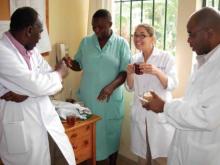When Dr. Andrea Zaenglein was a medical student at Pennsylvania State University doing her dermatology rotation, she heard a presentation that changed the course of her life.
The chief of the dermatology department at Penn State at the time, Dr. Donald Lookingbill, shared his experiences working at the Regional Dermatology Training Center (RDTC) in Moshi, Tanzania. He had spent more than 6 months there and was heavily involved with establishing educational programs for skin cancer prevention in patients affected with albinism. His story resonated with her, tapping into her dual interests in dermatology and pediatrics. "He inspired me to want to give back not just locally, but globally. ... The need for dermatologic care in Tanzania really hit home," Dr. Zaenglein said in an interview.
Fast forward more than 13 years to 2010, when Dr. Zaenglein finally felt like she was at a point in her life "to do something big," she called Dr. Lookingbill and arranged to spend 3 months working at the RDTC with her husband and 5-year-old son in tow.
Describe the clinic. What were the facilities like in terms of resources?
The RDTC is a well-funded, very modern clinic by African standards. They are very fortunate to have the support of the International Foundation for Dermatology, along with other generous benefactors. It is located on the grounds of the Kilimanjaro Christian Medical Center, but is run independently of the hospital. Upon entering the two-story clinic, there is a large, open waiting area with benches for the patients. There are 8 to 10 exam rooms, all with large windows in case the power goes out, which is not uncommon. There are two large surgical rooms, a dispensing pharmacy, large and small lecture rooms, an area for photography, and a pathology room with a microscope for reading histopathology slides.
The dermatology officers maintain separate male and female wards in the hospital dedicated to skin disorders. There are typically 10 to 12 patients on the ward at any given time, with disorders ranging from chronic leg ulcers to Kaposi’s sarcoma to toxic epidermal necrolysis.
How many patients did you see on a daily basis?
Outpatient clinic was held Monday, Wednesday, and Friday, from 9 a.m. until the day was done, typically around 2 p.m. We would see approximately 80 to 100 or so patients a day. Friday was the most popular clinic day. It was the pediatric day, when most of the kids came in. More than 40% of the Tanzanian population is under 15 years of age, but they have no pediatric dermatologist in all of East Africa. Nor do training programs have a formal pediatric dermatology curriculum.
What were the most common conditions?
We saw many of the conditions that I see in my patients here: atopic dermatitis, impetigo, and warts. However, there were different presentations. For example, there were several children with warts in the oral mucosa. We do not see that much in the United States. Also, because of the prevalence of HIV, many of the infectious diseases are much more extensive or advanced than what we see in the U.S., where HIV, especially advanced HIV, is uncommon in children. Disorders that we saw commonly in Tanzania that are not common in the U.S. included endemic Kaposi’s sarcoma and leprosy.
Did you have any unusual or puzzling cases?
Both albinism and xeroderma pigmentosum (XP) are very common in this part of East Africa. Because they are made worse by ultraviolet light exposure, patients present with extremely advanced and extensive skin cancers. The prevalence of albinism and the horrific targeting of affected individuals for their body parts are well publicized. I was surprised by the number of people with XP. One little girl with the disease arrived from hundreds of miles away, from a very remote part of Tanzania. She was only 4 years old and already had incredible numbers of lentigines covering both sun-exposed and non-exposed areas, where the sun had penetrated her clothing. She had numerous squamous cell carcinomas as well as basal cell carcinomas. Her eyesight was so compromised, she was essentially blind. We were able to provide the family with education about the disorder, including the role of sunlight and the need for constant protection from the sun, but the reality is that she lives in a country that lies just south of equator, and access to care is limited. Her prognosis, and that of others like her, is very grim.


